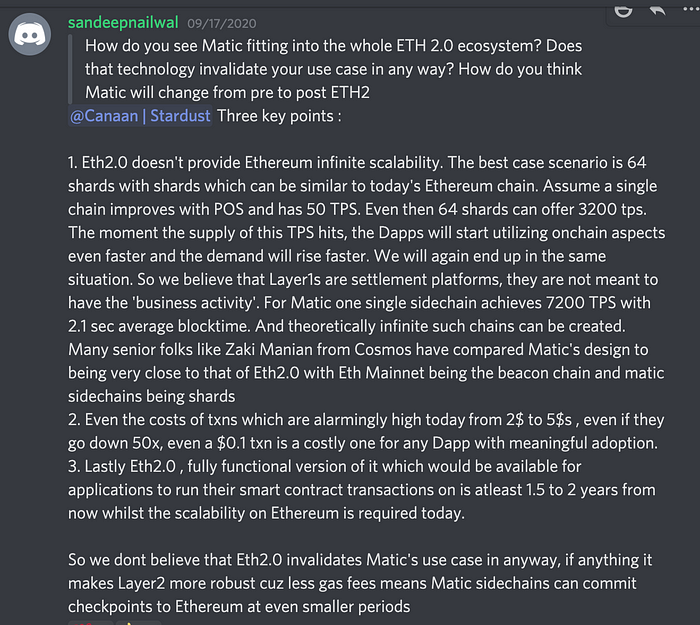Why Aavegotchi Chose Polygon
Our DeFi-powered collectibles game needed a Layer 2 solution. Here’s why we chose Polygon (formerly Matic).

When we launched our eco-governance token on Ethereum in September, it was the peak of the first DeFi season. Prices were rising, degens were aping, and morale was peaking. But under the ebullient surface, a storm was brewing…
Gas prices had spiked to levels not seen since 2017 and the famous CryptoKitties launch. Smaller players, unable to afford the expensive transactions, were being pushed to the sidelines as large holders cashed in on all the latest yield farming opportunities.
Developers, seeing their users fleeing the maelstrom, began to seriously consider whether developing on Ethereum was productive anymore. Out of the confusion emerged a Discord server, aptly named “The Great Migration” (TGM). Managed strictly by the admins, only developers could join and see the chat.

A furious debate ensued, as arcane terms like “rollups”, “validators” and “sharding” were tossed around. The server quickly grew to include channels for every scaling solution under the sun: Ethereum 2, Avalanche, Cosmos, Flow Blockchain, Polygon/Matic, NEAR, OMG Network, Polkadot, Skale, Solana, Starkware, xDAI, Rollups, and many more.
The conversation frothed, as A-List developers of almost every Ethereum dApp out there chimed in on their favorite potential scaling solutions.
And then…as quickly as it had started, the conversation died off. October came, and gas fees dropped back to earth. Developers collectively sighed in relief as their average transaction fees returned to under $50, and went back to doing what they do best: heads-down, #buidling the future.
In just four months, however, the gas fees would skyrocket again, bringing the problem back.
Ask Matic Anything (AMA)
Out of all the projects discussed on the TGM server during the DeFi boom’s first wave, notably, only one showed up to do an AMA (Ask Me Anything) session.
On September 17, Sandeep Nailwal of Polygon (which was called Matic Network at the time) was invited to join the hallowed ranks of TGM. Branded with a green “Project” Role (as opposed to the orange “Builder” role), Sandeep did not have access to the larger chat. He was invited for one specific purpose — to answer rigorous questions about how his project can solve the issue of scalability.

What is Polygon? (Formerly known as Matic)
Currently, Polygon offers a Layer-2 (L2) scaling solution that achieves scale by utilizing sidechains for off-chain computation while ensuring asset security using the Plasma framework and a decentralized network of Proof-of-Stake (PoS) validators — although the project plans to become a full-blown L2 aggregator that supports other L2 solutions such as Optimistic Rollups (OR), zkRollups (ZKR), and Validium.Critically, Polygon is fully compatible with the Ethereum Virtual Machine (EVM), meaning users from Ethereum can easily transfer their assets to Polygon, and developers can deploy existing Solidity contracts without any major changes.
During the AMA, Sandeep answered many important questions from the community, pertaining to security, developer experience, and roadmap. These answers, combined with our previous research and interactions with the team, convinced us that Polygon (then known as Matic) was a perfect fit for Aavegotchi.
Fast forward a few months to December. Gas was relatively cheap, the market was sideways, and we at Aavegotchi were actively preparing to launch.
Our original plan was to launch Aavegotchi collectibles on Ethereum and then allow users to transfer them to L2 to play the game. We scheduled the launch for January 4th, informed our media partners, and sprinted towards the finishing line.
Launch D(el)ay
As soon as the new year came, the crypto markets turned hectic again. The bull was back, and with it the extremely high transaction fees seen in September.
January 4th arrived, and our Discord was filled with a panicked, frenetic energy. Some members were excited about the launch despite the high gas fees, while others likened it to “setting sail in the middle of a hurricane.”
An impromptu Discord reaction vote revealed the truth: 75% of our users supported delaying the launch and aborting our previous “Launch, then Pivot” plan. Instead, they supported launching directly onto L2.
Many members asked us, “Why Matic? Why not xDAI, or Flow, or (any other L2 solution)? We had done a lot of research to come to this conclusion, but none of it had been previously disclosed publicly.
So here are the six reasons why we chose Matic/Polygon.
Reason 1: Sufficient Decentralization
Unlike many NFT projects, Aavegotchi NFTs contain real financial value, distinct from the speculative value of the NFT itself. Each Aavegotchi is staked with interest-bearing “aTokens” generated from Aave’s lending pool on Ethereum, that are 1:1 convertible for underlying tokens such as DAI, USDT, LINK, and AAVE.
Since we had to ensure the security of our players’ funds, our primary consideration when selecting the L2 home for Aavegotchi was sufficient security and decentralization of the network.
Polygon has made great strides in terms of gradual decentralization. There are currently around 90 validators staking MATIC (Polygon’s native asset) to secure the network, most of which are run by community projects with significant funds staked. Validators require a ⅔ majority consensus to validate transactions and create checkpoints on Mainnet.
Polygon uses a dual strategy of Proof-of-Stake at the checkpointing layer and Block Producers at the block producer layer to achieve faster blocktimes. It also ensures a high degree of decentralization by achieving finality on the main chains via the checkpoints and fraud-proof mechanisms.
Reason 2: EVM-Compatibility
One of our criteria for picking a viable L2 option is that it must be compatible with the Ethereum Virtual Machine and the contracts that run on it. Most L2 solutions do not fit this criteria. Some solutions have created their own languages, or require rewriting into languages like Rust. The only L2 scaling solutions that offer EVM-compatibility are Polygon, xDAI, and Optimistic Virtual Machine (OVM). So that narrowed it down, a lot.
Reason 3: Production readiness
Aavegotchi was ready to launch yesterday. Delaying our launch to wait for a solution like OVM or ETH Phase 2 to come fully online would hurt community morale and weaken our momentum. The world needs DeFi-backed pixel avatars NOW, even if they don’t know it yet.
So in the end, like the majority of crypto projects looking to have the best of both worlds by enjoying Ethereum’s huge network effect, while avoiding the network congestion, we were left with two options: xDAI and Polygon.
Polygon and xDAI are both viable competitors for the throne of “EVM-compatible sidechain”. Like siblings, they sometimes squabble and bicker, but at the end of the day, they are family and they share the same goal of helping to scale Ethereum. We did thorough research on both protocols, but in the end decided that Polygon met our needs better, for the following reasons.
Reason 4: Growing network effect
The total volume locked (TVL) on Polygon is growing quickly. As of publishing, it has already reached $200+ million, compared to xDAI’s $16 million. High gas costs are forcing projects on Ethereum to seriously consider migrating to L2, and as Polygon’s network effect grows, the incentive to migrate to Polygon will become ever stronger.
Reason 5: Great Developer Ecosystem
Polygon’s mechanism for bridging is extremely flexible. Recently, Aavegotchi Core Summoner Nick Mudge bridged Aave’s interest-bearing aTokens onto Matic/Polygon via a special customized bridge that allows them to retain their interest while on L2. It’s incredibly easy for existing protocols to begin moving their assets onto L2.
More and more developer tools such Chainlink are also launching on Polygon, giving existing Ethereum developers powerful building blocks in the new gasless environment.
Reason 6: Interoperability with other NFT projects
Polygon has a growing list of NFT dApps launched or planning to launch soon. A full list can be seen on their website, but some of our favorites are: Decentraland, Somnium Space, Zed Run, Terra Virtua, and Niftex. Notably, the NFT market OpenSea is launching on Polygon as well.
At this point, we hear about new NFT projects moving to Polygon almost daily. One of the overarching goals of Aavegotchi is to enable interoperability with other NFTs, so it is important that Aavegotchi exist in a growing ecosystem. Similarly, Polygon’s team has a strong focus on blockchain gaming and NFTs.
LFG! (Let’s Forge Greatness!)
Our community is very satisfied with our decision to launch on Polygon and is eagerly awaiting the game to launch. In fact, our users barely noticed the transition due to the familiar experience: the process of bridging tokens from Ethereum to Matic/Polygon is intuitive and as user-friendly as it gets, while infrastructure solutions like Quickswap DEX provided liquidity mining incentives to attract our users to their platform. There is one difference that truly catches the eye, however: the transactions are virtually free and much faster.
The Great Migration is just beginning, and it’s impossible to say what the ecosystem will look like in five years, but we believe in Polygon’s ambitious mission to ultimately make Ethereum “a full-fledged, powerful multi-chain system”. We are extremely excited to launch Aavegotchi’s DeFi-backed crypto avatars on their network.

